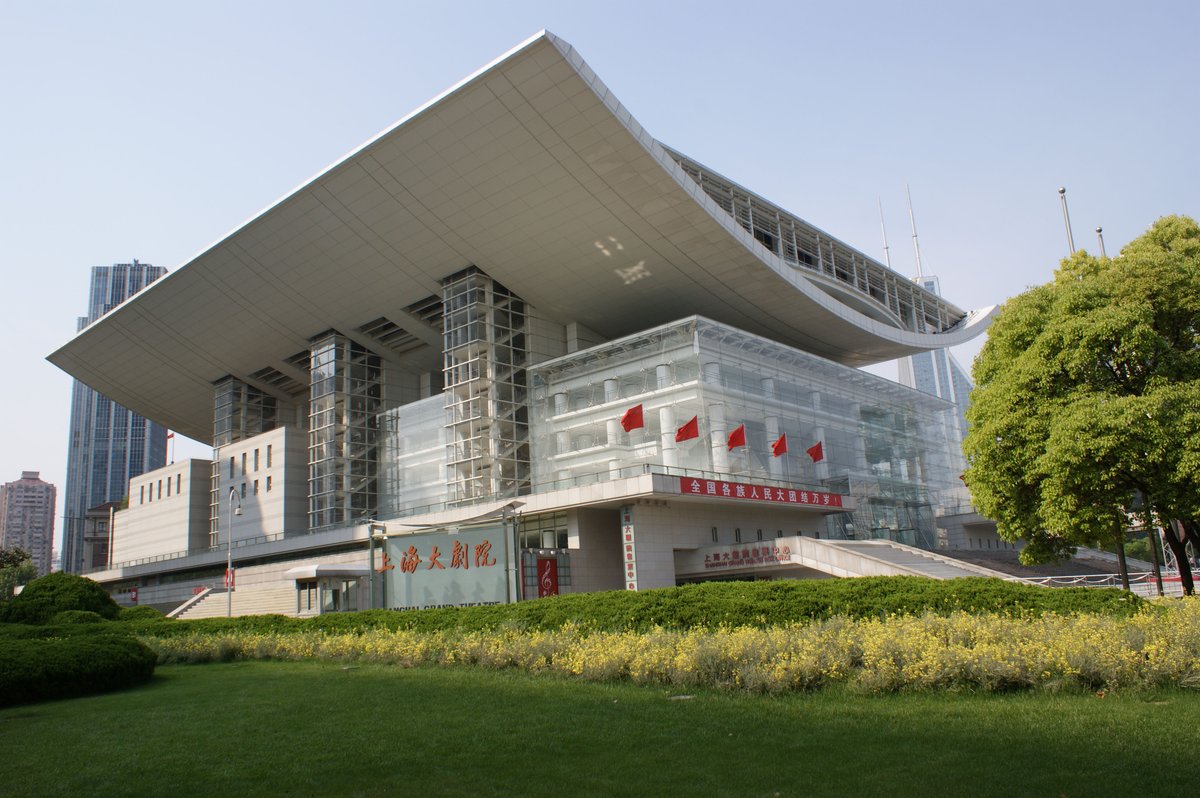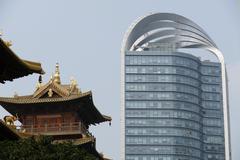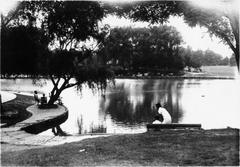
Shanghai Grand Theatre: Besuchszeiten, Tickets und vollständiger Besucherführer
Datum: 14.06.2025
Einführung
Das Shanghai Grand Theatre befindet sich im pulsierenden Herzen des Volksplatzes von Shanghai und ist ein Leuchtfeuer der kulturellen Renaissance der Stadt und ein Muss für Kunstliebhaber und Touristen gleichermaßen. Seit seiner Eröffnung im Jahr 1998 ist das Theater zum Synonym für erstklassige Aufführungen, architektonischen Glanz und Shanghais einzigartige Mischung aus östlicher Tradition und westlicher Modernität geworden. Entworfen vom renommierten französischen Architekten Jean-Marie Charpentier, symbolisieren seine Glasfassade und die geschwungenen Dachlinien Transparenz und künstlerische Offenheit und machen es zu einem Juwel im Stadtbild Shanghais.
Dieser umfassende Leitfaden behandelt die historische Bedeutung des Theaters, architektonische Highlights, Ticketpreise und Öffnungszeiten, Barrierefreiheit, Besuchereinrichtungen, nahegelegene Attraktionen und praktische Reisetipps. Egal, ob Sie eine große Oper besuchen, an einer Führung teilnehmen oder einfach nur sein Design bewundern möchten, dieser Artikel bietet alle wesentlichen Informationen für einen bereichernden Besuch.
Konsultieren Sie für offizielle Spielpläne und Ticketpreise die offizielle Website des Shanghai Grand Theatre. Weitere Einblicke finden Sie auf ShanghaiViva und China Expedition Tours.
Inhaltsverzeichnis
- Ursprünge und historischer Kontext
- Architektonische Vision und Merkmale
- Kulturelle und künstlerische Wirkung
- Besuchsinformationen
- Sonderveranstaltungen und bemerkenswerte Aufführungen
- Nahegelegene Attraktionen
- FAQs
- Empfehlungen für Bilder und Medien
- Planen Sie Ihren Besuch und bleiben Sie auf dem Laufenden
- Referenzen
Ursprünge und historischer Kontext
Das Shanghai Grand Theatre (上海大剧院) wurde als Reaktion auf Shanghais rasante Modernisierung und die wachsende Nachfrage nach einer erstklassigen Spielstätte für darstellende Kunst in den 1990er Jahren erbaut. Die Transformation und die kulturellen Ambitionen der Stadt gipfelten in der feierlichen Eröffnung des Theaters am 27. August 1998. Seitdem ist es die Heimat der Shanghai Opera House und eine Bühne für ein beeindruckendes Spektrum an Aufführungen, von traditioneller chinesischer Oper bis hin zu internationalen Kooperationen, was Shanghais Aufstieg zu einem globalen Kunstzentrum markiert (ShanghaiViva; China Expedition Tours).
Architektonische Vision und Merkmale
Konzept und Design
Die Vision des französischen Architekten Jean-Marie Charpentier war es, einen „Kristallpalast“ zu schaffen, der östliche und westliche Designelemente miteinander verbindet. Die ikonischen Glasvorhangwände und geschwungenen weißen Dachlinien spiegeln die kosmopolitische Energie Shanghais wider und bieten eine leuchtende Präsenz, insbesondere wenn sie nachts beleuchtet werden (ShanghaiViva; China Expedition Tours).
Aufführungssäle
Das Theater erstreckt sich über mehr als 62.000 Quadratmeter und umfasst drei Hauptaufführungsräume:
- Lyric Theatre (Hauptsaal): Bietet Platz für 1.800 Zuschauer und ist ideal für Opern, Ballette und Symphonien. Sein großartiges Design sorgt für hervorragende Akustik und klare Sichtlinien (China Travel).
- Drama Theatre: Bietet Platz für 600–750 Gäste und ist perfekt für Theaterstücke und Kammermusik geeignet.
- Studio Theatre: Ein intimer, flexibler Raum mit 220–300 Plätzen für experimentelle und zeitgenössische Aufführungen.
Technologische Innovationen
Das Theater ist mit fortschrittlicher Bühnentechnik ausgestattet, darunter ein vollautomatisches Waagner Biro-System für komplexe Produktionen, modernste Meyer Sound-Audiosysteme und belgische ADB-Beleuchtung. Diese Funktionen bieten technische Vielseitigkeit für die Ausrichtung von Veranstaltungen auf internationalem Niveau (China Travel).
Kulturelle und künstlerische Wirkung
Seit seiner Eröffnung ist das Shanghai Grand Theatre eine lebendige Bühne für künstlerischen Austausch und Innovation. Es arbeitet regelmäßig mit renommierten Institutionen wie dem Royal Opera House und den Salzburger Festspielen zusammen, veranstaltet Premieren chinesischer Originalwerke und organisiert Bildungsprogramme zur Förderung lokaler Talente (ShanghaiViva). Sein Programm spiegelt eine Balance zwischen klassischen Meisterwerken und avantgardistischer Experimentierfreude wider und macht es zu einem zentralen Bestandteil der kulturellen Identität Shanghais (China Expedition Tours).
Besuchsinformationen
Besuchszeiten
- Kasse: Täglich von 8:00 bis 22:30 Uhr (China Highlights)
- Führungen: 09:00–11:00 und 13:00–16:00 Uhr
- Aufführungszeiten: Variieren je nach Veranstaltung; überprüfen Sie den offiziellen Spielplan
Ticketpreise und Kauf
- Kaufoptionen: Kasse, offizielle Website, autorisierte Agenten und vertrauenswürdige Online-Plattformen wie Damai, Maoyan und Trip.com.
- Preise: Von 80 CNY (lokale Shows) bis über 1.200 CNY (große internationale Produktionen). Studenten-, Senioren- und Gruppenermäßigungen können gelten.
- Führungstickets: 5 CNY für geführte Touren (China Travel).
- Sitzplatzauswahl: Plätze im Erdgeschoss des Lyric Theatre bieten optimale Sicht; höhere Etagen bieten unterschiedliche Perspektiven (ChinaTripedia).
- Abholung: E-Tickets werden am Ticketschalter gescannt; physische Tickets können mit Ausweis abgeholt werden.
- Rückerstattungen/Stornierungen: Variieren je nach Veranstaltung und Agentur.
Barrierefreiheit
- Metro: Linien 1, 2 und 8 zur Station People’s Square, Ausgang 11 (China Highlights)
- Bus: Mehrere Linien halten an Wushenglu Huangpo Beilu (China Highlights)
- Einrichtungen: Rollstuhlgerechte Rampen, Aufzüge, barrierefreie Toiletten, reservierte Sitzplätze und geschultes Personal (GoComGo)
- Parken: Sicheres Tiefgaragenparken mit behindertengerechten Stellplätzen (GoComGo)
Besuchereinrichtungen
- Elegante Lobby mit Marmorböden und einem großen Kronleuchter
- VIP-Lounge und private Räume für besondere Gäste
- Buchhandlung, Café und französisches Restaurant Maxim’s of Paris
- Einzelhandelszentrum mit Souvenirs und Aufführungsaufzeichnungen
- Kostenloses WLAN, Garderobe und saubere Toiletten auf allen Etagen (China Travel)
Reisetipps
- Kommen Sie mindestens 30 Minuten vor Beginn der Aufführung an
- Gepflegte Freizeitkleidung (Smart Casual) wird empfohlen
- Fotografieren in öffentlichen Bereichen gestattet, jedoch nicht während der Aufführungen
- Überprüfen Sie die Sprache/Untertitel von internationalen Shows
Sonderveranstaltungen und bemerkenswerte Aufführungen
Der jährliche Kalender des Theaters umfasst internationale Musikfestivals, Themensaisons, Premieren chinesischer Opern und Kooperationen mit führenden globalen Unternehmen. Zu den Höhepunkten zählen die chinesischen Premieren von „Schwanensee“, „Carmen“ und „La Traviata“ sowie innovative Veranstaltungen, die sich mit der Schnittstelle von Kunst und Technologie beschäftigen (English Shanghai Gov).
Nahegelegene Attraktionen
Ergänzen Sie Ihren Besuch mit diesen nahegelegenen Sehenswürdigkeiten:
- Volksplatz & Park: Grünfläche und öffentlicher Versammlungsort
- Shanghai Museum: Bekannt für seine umfangreichen Kunst- und Artefaktsammlungen
- Urban Planning Exhibition Center: Interaktive Darstellung der Entwicklungsgeschichte Shanghais
- Nanjing Road: Erstklassige Einkaufs- und Gastronomie-Straße (ChinaTripedia; Trip.com)
- Der Bund, Yu Garten, Xintiandi: Ikonische Wahrzeichen in kurzer Fahrzeit (China Discovery)
FAQs
F: Was sind die Besuchszeiten des Shanghai Grand Theatre? A: Die Kasse ist täglich von 8:00 bis 22:30 Uhr geöffnet. Führungen sind von 09:00–11:00 und 13:00–16:00 Uhr möglich. Die Aufführungszeiten variieren.
F: Wie kaufe ich Tickets? A: Kaufen Sie Tickets an der Kasse, online über die offizielle Website oder über autorisierte Agenten.
F: Gibt es Rabatte? A: Ja, für Studenten, Senioren und Gruppen bei ausgewählten Aufführungen.
F: Ist das Theater barrierefrei? A: Vollständig barrierefrei mit Rampen, Aufzügen und reservierten Sitzplätzen für behinderte Gäste.
F: Werden Führungen angeboten? A: Ja, außerhalb der Aufführungszeiten. Eine Vorabbuchung wird empfohlen.
F: Was ist der Dresscode? A: Gepflegte Freizeitkleidung (Smart Casual) wird insbesondere für Abendveranstaltungen empfohlen.
F: Sind die Aufführungen auf Englisch? A: Viele internationale Shows bieten englische Untertitel oder Programme.
F: Wie lautet die Fotoregelung? A: In öffentlichen Bereichen gestattet, aber nicht während der Aufführungen.
Empfehlungen für Bilder und Medien
- Verwenden Sie hochauflösende Fotos von der Fassade, dem Auditorium und den Innenräumen des Theaters.
- Fügen Sie Alt-Texte wie „Shanghai Grand Theatre Außenansicht bei Nacht“, „Bestuhlung des Hauptauditoriums“ und „Studio Theatre flexibler Raum“ hinzu.
- Betten Sie interaktive Karten ein, die den Standort des Theaters und nahegelegene Metro-Stationen hervorheben.
Planen Sie Ihren Besuch und bleiben Sie auf dem Laufenden
Erleben Sie das Beste der darstellenden Kunst und architektonischen Innovationen Shanghais im Shanghai Grand Theatre. Laden Sie die Audiala App für aktuelle Aufführungspläne, Ticketbuchungen und exklusive Inhalte herunter und folgen Sie den offiziellen Social-Media-Kanälen des Theaters.
Bleiben Sie über bevorstehende Veranstaltungen informiert und genießen Sie nahtlosen Zugang zu Shanghais kulturellen Schätzen.
Referenzen
- Offizielle Website des Shanghai Grand Theatre
- ShanghaiViva
- China Expedition Tours
- China Travel
- China Highlights
- Shanghai Government English
- GoComGo
- ChinaTripedia
- Trip.com
- China Discovery
Audiala2025This article provides an in-depth exploration of the theatre’s history, architectural significance, cultural importance, visitor experience, ticketing, accessibility, and nearby attractions. Drawing on a wide range of authoritative sources, this guide aims to equip travelers and culture enthusiasts with all the essential information needed for a memorable visit to one of Shanghai’s most iconic landmarks.
Historical Background
Origins and Construction
The Shanghai Grand Theatre (上海大剧院) was conceived in the early 1990s as part of a broader initiative to revitalize People’s Square and establish Shanghai as a global cultural metropolis. In 1994, the theatre was identified as a key component of the People’s Square renovation project. An international architectural competition was launched in 1994, attracting submissions from 15 renowned firms worldwide. The French architectural firm Arte Charpentier, led by Jean-Marie Charpentier, won the commission for its profound interpretation of Shanghai’s cultural and historical context (Arte Charpentier).
Construction began shortly thereafter, and the theatre was completed in just four years—a testament to the collaborative efforts of thousands of workers and the fusion of Chinese and Western architectural wisdom. The Shanghai Grand Theatre officially opened its doors on August 27, 1998, with a performance of the ballet “Swan Lake” (Arte Charpentier).
Milestones
Since its inauguration, the theatre has staged over 6,000 performances, including operas, ballets, symphonies, musicals, and spoken dramas. It has hosted world-renowned companies such as the Berlin Philharmonic, the Bolshoi Ballet, and the Vienna State Opera, as well as prominent Chinese artists and ensembles (China Highlights; Chinatripedia). In 2019, the Shanghai Grand Theatre was recognized as one of the “Top Ten New Landmark Buildings in Shanghai,” cementing its status as a cultural icon (Arte Charpentier).
Architectural Significance
Design Philosophy
The Shanghai Grand Theatre’s design is a harmonious blend of traditional Chinese and contemporary Western architectural elements. The most distinctive feature is its roof, which is shaped like an inverted arch with two upturned sides, symbolizing the unity of heaven and earth—a concept deeply rooted in Chinese cosmology. The white roof, reminiscent of the pavilions found in classical Chinese gardens, is supported by prominent columns and framed by glass curtain walls, creating a visual effect akin to a crystal palace (Arte Charpentier; China Highlights).
The building stands 40 meters tall, with ten stories (eight above ground and two below), and covers a surface area of 55,000 square meters. The steel used in the roof alone is nearly equivalent in weight to that of the Eiffel Tower, underscoring the scale and ambition of the project (Arte Charpentier).
Symbolism and Innovation
The theatre’s architectural form is rich in symbolism. The white inverted arches on the roof evoke the ancient Chinese saying, “the sky is round and the earth is square,” while the Jiugongge (nine-square grid) layout pays homage to the Kyushu order of the “Rites of Zhou,” reflecting Shanghai’s openness and cosmopolitan spirit (Arte Charpentier).
Technologically, the Shanghai Grand Theatre was a pioneer in China, being one of the first cultural buildings to feature a steel-framed glass curtain wall. Its state-of-the-art stage machinery and computerized lighting and sound systems enable it to host the most complex and demanding productions (Chinatripedia).
Cultural Importance
A Bridge Between East and West
The Shanghai Grand Theatre is not only a venue for artistic performances but also a symbol of Shanghai’s role as a bridge between Eastern and Western cultures. Its programming reflects this duality, featuring both Chinese and international works, and fostering cultural exchange and dialogue. The theatre has become an important window for the communication of Chinese culture to the world and for the introduction of global artistic trends to China (China Highlights).
Artistic Legacy
The theatre’s main stage curtain, designed by French abstract expressionist Olivier Debré, is itself a work of art, exemplifying the collaboration between Chinese and Western artists. The venue regularly hosts art markets, workshops, and exhibitions, further enriching Shanghai’s cultural landscape (Arte Charpentier; Chinatripedia).
Visitor Experience
Performance Spaces
The Shanghai Grand Theatre houses three main performance spaces, each designed to accommodate different types of productions:
-
Main Auditorium (Great Theater):
- Capacity: 1,800 seats
- Description: A grand, multi-level space ideal for operas, ballets, symphonies, and large-scale productions. The auditorium is decorated in traditional French style, with three tiers of seating (China Highlights; Chinatripedia).
-
Drama Theater (Middle-sized Theater):
- Capacity: 600+ seats
- Description: An intimate venue for drama, dance, and small-scale performances. It is luxuriously decorated and often hosts Shanghai local operas (China Highlights).
-
Studio Theater (Small-sized Theater):
- Capacity: 300 seats
- Description: A flexible space suitable for chamber music, experimental theatre, and fashion shows. Located on the fifth floor, it covers 400 square meters (China Highlights).
Amenities and Facilities
-
Lobby and Recreational Hall: The spacious lobby (nearly 2,000 square meters) is adorned with a large crystal chandelier and Greek-style white marble flooring, creating an atmosphere of elegance and grandeur. The recreational hall (2,000 square meters) features large-scale chandeliers and marble decor, offering a sense of holiness and sophistication (China Highlights; Chinatripedia).
-
Banqueting and Dining: The ship-shaped banqueting hall on the top floor provides panoramic views of People’s Square. The Maxim Restaurant, a 1,600-square-meter Western-style eatery, is a romantic spot for pre- or post-show dining (China Highlights).
-
Art Gallery and Bookstore: A 250-meter-long art gallery and an in-house bookstore offer opportunities for cultural enrichment and souvenir shopping (Chinatripedia).
-
Other Facilities: The theatre is equipped with VIP halls, café bars, and a large parking lot, ensuring comfort and convenience for all visitors (China Highlights).
Ticketing and Booking
How to Purchase Tickets
-
Online Booking: It is highly recommended to book tickets online in advance, especially during holidays and weekends, to avoid long queues and secure preferred seats. The official website and major ticketing platforms accept international credit cards and provide English-language interfaces. After booking, tickets are typically delivered as QR codes for easy entry (Chinatripedia; Ruqin Travel).
-
On-site Purchase: Tickets can also be purchased at the theatre’s box office, but availability may be limited during peak periods.
Ticket Prices
Ticket prices vary depending on the performance, seating category, and production scale. As of 2025, prices for major performances typically range from 100 to 1,000 RMB (approximately $15 to $150 USD), with discounts sometimes available for students, seniors, and group bookings (Chinatripedia).
Entry and Security
Visitors should arrive at least 30 minutes before the performance to allow time for security checks and ticket validation. The entrance area features a bookstore and café, providing a pleasant waiting environment (Chinatripedia).
Accessibility and Transportation
Location
- Address: 300 Renmin Avenue, Huangpu District, Shanghai, China
- Coordinates: Near the intersection of Renmin Avenue and Huangpi North Road, at the northern edge of People’s Square (Chinatripedia).
Public Transportation
-
Subway:
- Lines 1, 2, and 8: Alight at People’s Square Station (人民广场站), Exit 11. The theatre is a 100-meter walk from the exit (Chinatripedia; China Highlights).
-
Bus:
- Routes 17, 20, 23, 37, 46, 48, 49, 71, 108, 109, 112, 123, 505, and 506 all stop near the theatre (China Highlights).
Accessibility
The theatre is designed to be accessible to visitors with disabilities, featuring ramps, elevators, and designated seating areas. Staff are available to assist with special needs upon request (Chinatripedia).
Visitor Tips
Best Time to Visit
-
Performance Schedule: The theatre hosts performances throughout the year, with peak seasons during major holidays and international festivals. It is advisable to check the official schedule and book tickets well in advance for popular shows (Chinatripedia).
-
Recommended Visit Duration: Most visitors spend 2–3 hours at the theatre, including time for exploring the lobby, art gallery, and amenities (TripHobo).
Seating Advice
-
Main Auditorium: The first floor offers the best views. Rear rows on the second floor may have obstructed sightlines, and the third floor is quite high—consider this when selecting seats (Chinatripedia).
-
Other Theatres: The medium-sized and small theatres have a friendly slope, ensuring good visibility from most seats.
Exploring Amenities
- Arrive early to explore the bookstore, café, and art gallery before the show.
- Check for special events such as art markets and workshops, which are occasionally held in the theatre’s public spaces (Chinatripedia).
Dress Code
While there is no strict dress code, smart casual attire is recommended, especially for evening performances.
Photography
Photography is generally not permitted during performances, but visitors are welcome to take photos in the lobby and public areas.
Nearby Attractions
The Shanghai Grand Theatre’s central location makes it an ideal starting point for exploring some of the city’s most famous attractions:
-
People’s Square: A major public space and transportation hub, perfect for people-watching and city views.
-
Shanghai Museum: Renowned for its extensive collection of Chinese art and artifacts, located just steps from the theatre (China Highlights).
-
Shanghai Urban Planning Exhibition Center: Offers fascinating insights into the city’s past, present, and future through interactive displays and scale models (Gold Supplier Blog).
-
Nanjing Road: One of the world’s busiest shopping streets, ideal for retail therapy and culinary exploration (Chinatripedia).
-
The Bund: Shanghai’s iconic waterfront promenade, offering stunning views of the city’s skyline (East China Trip).
-
Yu Garden: A classical Chinese garden, perfect for a tranquil escape from the urban bustle (Ruqin Travel).
-
Oriental Pearl TV Tower: A futuristic landmark with observation decks and entertainment facilities (Ruqin Travel).
Conclusion
The Shanghai Grand Theatre is a testament to Shanghai’s dynamic fusion of tradition and modernity. Its architectural grandeur, cultural vibrancy, and central location make it an essential destination for anyone seeking to experience the city’s artistic pulse. Whether attending a world-class performance, marveling at its innovative design, or exploring the surrounding cultural landmarks, visitors are sure to leave with lasting memories and a deeper appreciation for Shanghai’s unique place on the global stage.
Based on the evidence, the Shanghai Grand Theatre is not only a venue of exceptional artistic merit but also a living symbol of Shanghai’s openness, ambition, and cosmopolitan identity. Its thoughtful design, cutting-edge facilities, and diverse programming ensure that it remains at the forefront of China’s cultural renaissance.
References
- Arte Charpentier
- China Highlights
- Chinatripedia
- TripHobo
- Ruqin Travel
- Gold Supplier Blog
- East China Trip






















































































